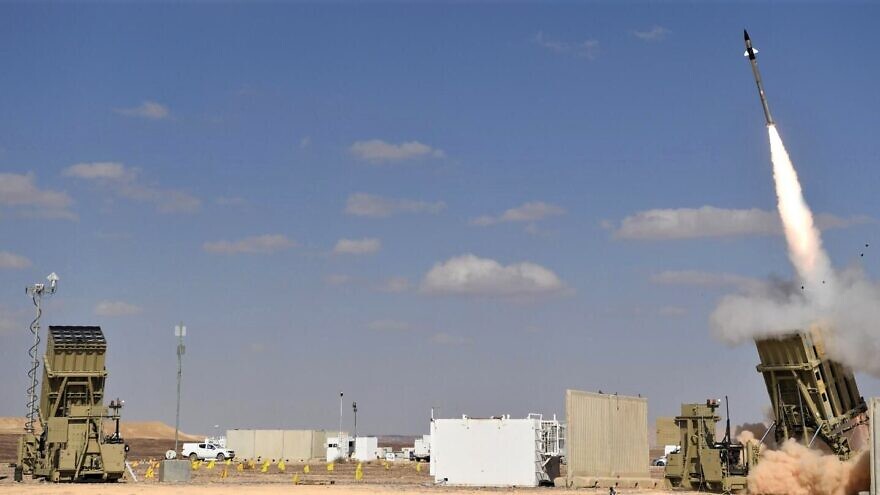Following the dramatic U.S. Marine Corps live-fire drill in July, Brig. Gen. (res.) Shachar Shohat tells JNS about the significance of the test, as well as the separate U.S. Army deployment of the Iron Dome batteries it already purchased.
BY YAAKOV LAPPIN
(August 4, 2022 / JNS) A recent United States Marine Corps live-fire trial of challenging aerial threats using the Israeli-made, Rafael Advance Defense Systems-produced Iron Dome air-defense system is a firm reply to those who claimed that Israeli and American systems would struggle to link up, a senior Rafael executive has told JNS.
On July 18, the Marine Corps announced a major breakthrough in its ability to integrate the Israeli-made Iron Dome ground launcher and Tamir interceptor missile into its air-defense systems.
In a statement, Rafael said that the Marines had integrated Iron Dome into the Marine Corps Medium-Range Intercept Capability (MRIC) Prototype. This system includes a radar known as G/ATOR (Ground/Air Task-Oriented Radar), which is made by American company Northrop Grumman, and a battle-management system, produced by U.S. defense giant Lockheed Martin.
The live-fire test at the White Sands Missile Range in New Mexico demonstrated that the U.S. Marine Corps has Iron Dome defense capabilities and that Iron Dome was effectively incorporated into USMC Architecture, said Israeli and American officials.
The technology performed precisely as predicted by a Marine simulation conducted prior to the actual test, according to Rafael.
Don Kelley, program manager for ground-based air defense at the Marine Corps Program Executive Office for Land Systems, stated immediately after the test: “This demonstration proves that we do now have a relevant capability.”
‘Significant milestone in a series of tests’
Brig. Gen. (res.) Shachar Shohat, vice president of Rafael, as well as head of strategy and commercial development for the Missile and Air Defense Division of Rafael, told JNS that the live trial is part of a years-long process aimed at getting Iron Dome ready to defend American Marines on their expeditionary (overseas) missions.
“The Marines can be in any place in the world, and they are searching for air-defense solutions against this type of designated threat. From the moment they land at their destination—via the sea or another way and onwards—they require an ability to defend against threats,” said Shohat.
He noted that Rafael, together with its American partner company, Raytheon—the primary contractor for the project in the United States—and the U.S. Marines have been engaged in years of in-depth dialogue.
“This trial, the third of its kind, is a significant milestone in a series of tests, in which the Marines are testing the suitability of the system that was developed for their needs,” he said. “We are talking about a defense system that is not only against rockets but also more complex threats like unmanned aerial vehicles and cruise missiles. The Marines are challenging themselves—and us.”
The live-fire trial saw simulated threats of extremely complex natures, testing the limits of the system, as well as simulating future enemy capabilities.
The ability to integrate radars, as well as command and control systems from Northrup Grumman and Lockheed Martin, is a key development for the test series, according to Shohat, which goes beyond interception abilities. “To a certain extent, it’s also a reply to those who claimed that Israeli systems can’t connect to American systems,” he said.
After completing the final step in the trial series, Rafael and its U.S. partners will examine ways to turn the trial into a procurement contract.
‘Joint factory on American soil’
Meanwhile, in a separate development, Rafael announced on Aug. 2 that the U.S. Army is operationally deploying one of the two Iron Dome batteries it had purchased, following a successful live-fire trial in New Mexico.
Dubbed by the U.S. Army as “Iron Dome Defense System-Army (IDDS-A),” the battery will defend military installations against subsonic cruise missiles, unmanned aerial vehicles, rockets, artillery and mortar threats, according to the statement.
The two programs are unrelated, said Shohat, though the common denominator is that both involve Rafael, Raytheon and the U.S. Military.
Rafael is assisting in the training of U.S. personnel that will operate the system. “At this stage, our obligation to deliver two batteries has been fulfilled, and the [American] personnel has been trained to be able to conduct the process of absorbing and integrating the system,” said Shohat.
One of the batteries was stationed at the U.S. military base on Guam in the North Pacific Ocean, before returning to the United States. Currently, both Iron Dome batteries are on American soil and both are operational.
Rafael’s strategic partnership with Raytheon in air defense includes the David’s Sling system as well, which Raytheon dubs SkyCeptor.
“We have a teaming agreement for the establishment of a joint factory on American soil, and progress is being made on that,” said Shohat.
He noted that the factory will be designed to produce interceptors of both kinds of systems for international clients and friendly states in the future, saying this could enable states to efficiently utilize U.S. foreign military aid funds while creating jobs for American citizens.
